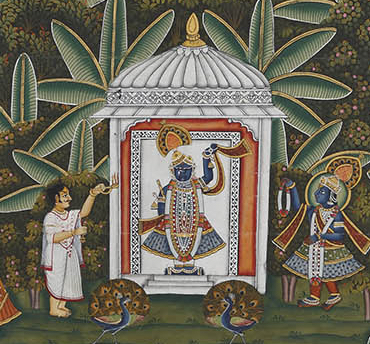When people of the Vaghri community of Gujarat were barred from entering temples due to their caste, they made their own shrines that could travel with them. Painting depictions of the Mother Goddess onto a piece of cloth, they created an art form called Mata-ni-Pachedi, Gujarati for ‘behind the mother goddess’. These painted textiles were used in nomadic shrines as wall-hangings and canopies, the latter known as Mata-no-Chandarvo.
The Chitara family of Ahmedabad has been practising this art form for over six generations. (The Sarmaya collection houses art made by three generations of this family: Manubhai Chitara, Sanjay Chitara, Sumit Chitara.) It was a drought that forced them to migrate to urban centres and eventually make a home in Khanpur in the Old City, where they have practised their art for over two centuries.
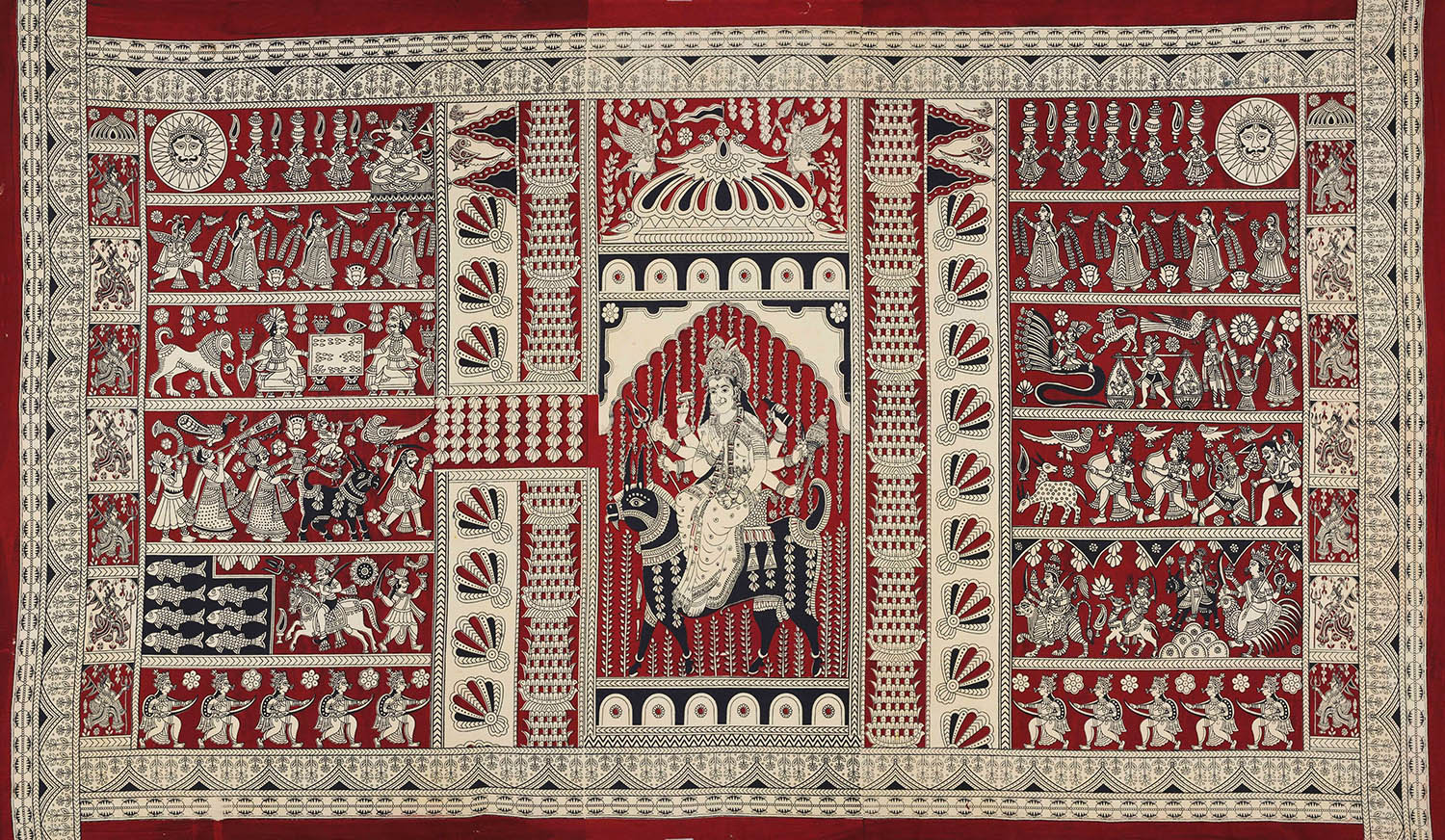
Meladi Mata, Dye on cloth, Manubai Chitara © Sarmaya Arts Foundation
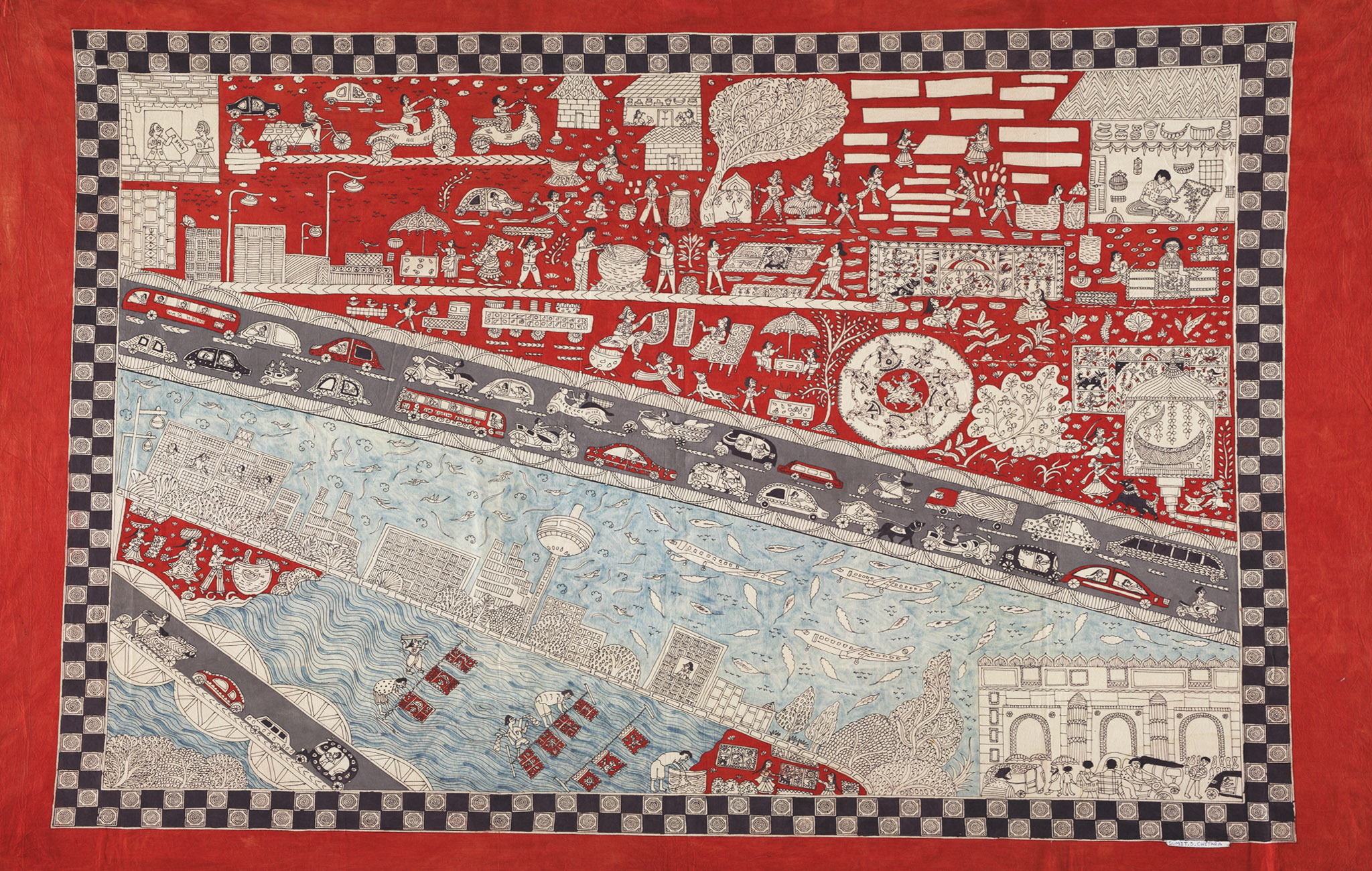
Patang, Mata ni Pachedi, Sumit Chitara, 2019 © Sarmaya Arts Foundation
The making of a Mata-ni-Pachedi textile involves several age-old practices. Traditionally, a coarse khadi textile was used but in more recent times, the community has moved to using smoother, mass-produced woven cloth. The process of dyeing is primarily done by Muslim craftsmen. In The Dyer’s Art, a book documenting the art form of resist dyeing as it is practised across continents, Alfred Buhler identifies this method as ‘Turkish red carbon and resist decoration’. The fabric is first washed, stretched and beaten on the banks of the Sabarmati. It is then sent to fabric washers of the Saragda caste and mordant dyers, both of whom are based in Ahmedabad.
The Vaghris print the borders using blocks of mud and wood, hand-paint the central goddess and fill in colour. They use an ink pad for hand-block printing, a flat, square wooden case with a sieve made of bamboo sticks. A cloth pad is placed on the sieve so the ink is released evenly when the block is pressed on the cloth. This also protects the ink from drying out because as soon as the pressure is removed from the cloth, the ink sinks back into the pad. Earlier, all elements of the canopy or Chandarvo with the exception of the central figure were block-printed. But today, artists like Sanjay Chitara paint these entirely by hand.
Traditionally, only red and black paint was used on the Chandarvo. Some artists believe these to be the goddesses’ favourite colours. To create the black ink, textile printers collect scrap iron, like nails, utensils etc, and place them in a barrel covered with a mixture of jaggery and water. The solution is then left to soak till it yields a black liquid. This is boiled with tamarind-seed flour, which turns it into a thick slime. In another container, hirakasi powder (iron acetate) and castor oil is mixed. The two solutions are finally mixed together to create the black ink.
Black is used to outlines the icons and motifs as it is believed to intensify the painting’s spiritual energy. The red symbolises Mother Earth and blood, which is a sacred feature of Mother Goddess worship. The white of the cloth symbolises purity and benediction from ancestral spirits and deities.
A mixture of alum and tamarind flour is prepared and used for filling in the colour. Once the colour is filled, the cloth is washed, dried and sent to the dyers. The textile is immersed in a boiling mixture of dhavdha flowers (axlewood) and alizarin. The alum in the painting reacts to the alizarin solution to turn the textile red. This process takes about three hours, during which time the dyers have watch the process carefully to make sure no part of the cloth is burnt. The cloth is once again washed in the river and left to dry on its banks.
Sanjay Chitara explains in an interview “Before the riverfront (Sabarmati) project we had no problems with the washing process. But after the project was executed, our work related to the washing process has completely stopped and no help has been offered by the government. An open area with flowing water is needed but now we face huge problems due to the lack of these. The natural colours used in the painting are affected because the water also contains unwanted chemicals. These react with the natural vegetable colours used, as a result, the intensity of the colour begins to fade. Black looks grey, red looks kind of pink and overall the result isn’t what it should be, or what had been envisioned by the artist.”
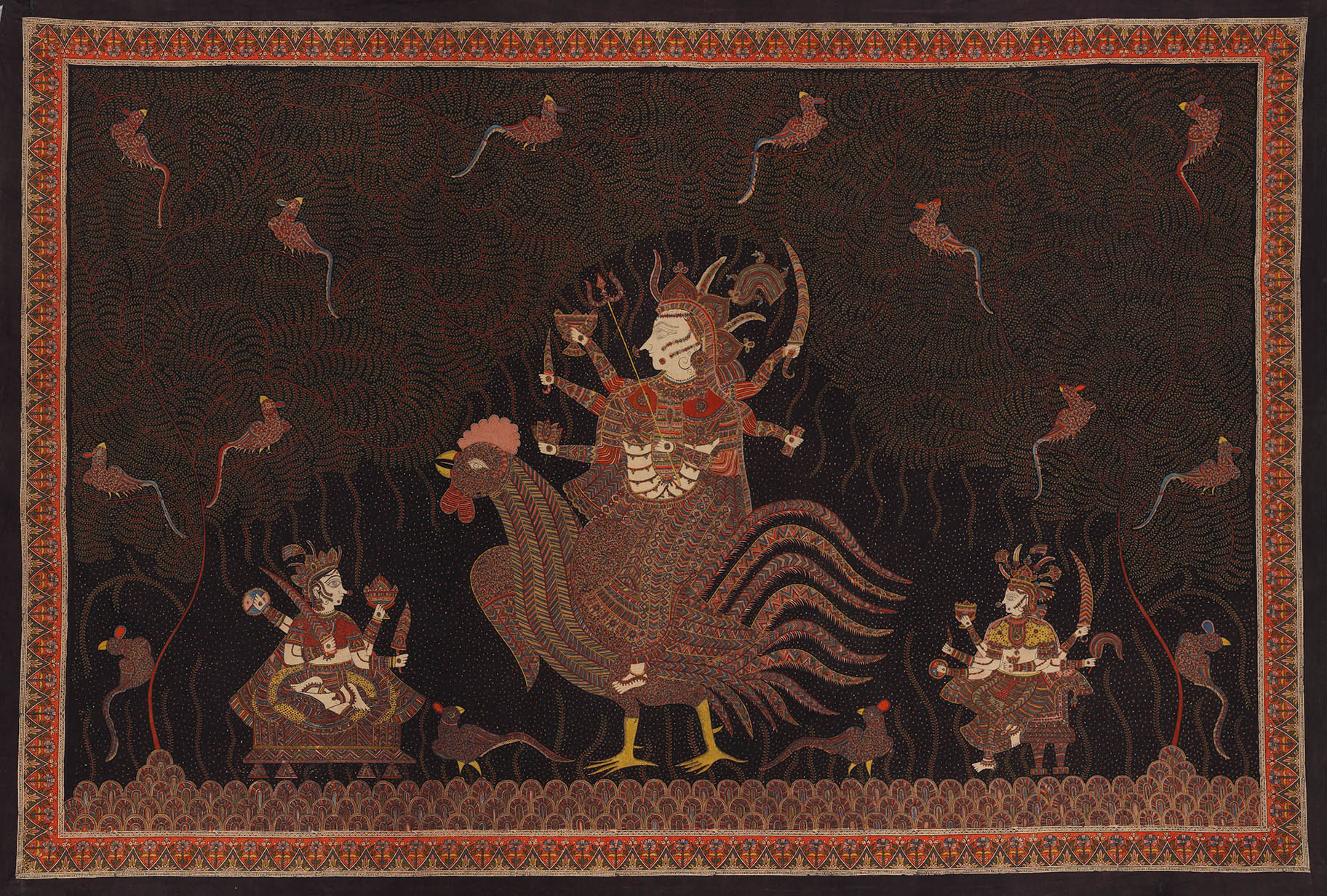
Bahuchara Mata, Cotton cloth hand painted and block printed with natural dyes, Sanjay M Chitara © Sarmaya Arts Foundation
The Sabarmati originates in Dhebar lake, situated in the southern Aravallis, and it flows south-west passing through cities like Udaipur, Sabarkantha and Mehsana in Rajasthan and Gujarat. It travels hundreds of kilometres before emptying into the Gulf of Khambhat. It is on the banks of this great river that Ahmedabad was founded in 1411, and it is from here that MK Gandhi began the Salt Satyagraha in 1930. In the last few decades, however, the sanctity of the river has been under attack from human and industrial pollution. The polluted water affects the quality of the natural colours in the Mata-ni-Pachedi paintings. The Sabarmati has also dwindled in force due to the embarkments built along its riverfront, making the dyeing and washing processes less effective. As a result, many contemporary practitioners now use alternative techniques and experiment with mediums to reduce their dependence on the river. Thus severing a centuries-old bond that has coloured every aspect of this traditional art form.
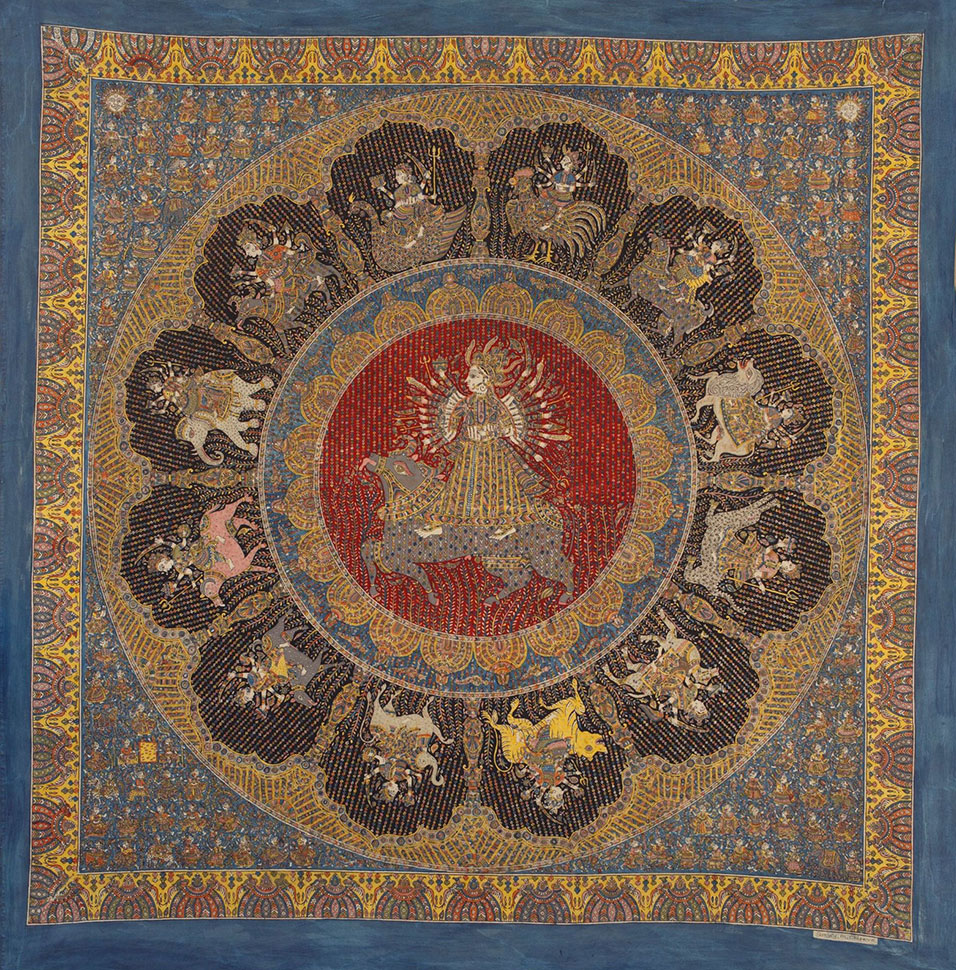
Vishat Mata, Cotton cloth hand-painted and block-printed with natural dyes, Sanjay M. Chitara © Sarmaya Arts Foundation
With inputs from Kuhu Kopariha
References:
– Source Academia: Diagnostic Study: Mata-ni-Pachedi by Bishakha Shome
– Paryavaran Suraksha Samiti and Gujarat Pollution Control Board report
– Temple Hangings by Prof. Birudutta Baral, Lija M. G., Srikant B. and Vijay G.
– J M Malkan, ‘Vagharis of Gujarat an ancient tribe: Facing crucial change and anti-historical process’
– Eberhard Fischer, 2014, Temple tents for Goddesses in Gujarat, India, Niyogi Books.
– Sunita Nair, 2018, Indigenous Artists, India



